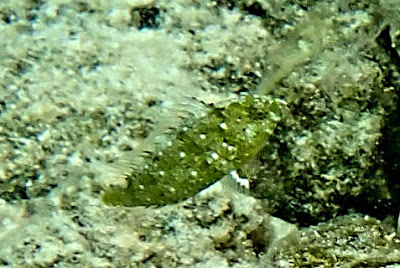 |
| Hawaiian Shrimp Goby. Kawaihae May 2020 |
Once Peter started looking for shrimp gobies, we discovered how we missed them on our first attempt. We had been looking around rocks out in the sand, where as the shrimp gobies are right at the junction where the sloping rocky littoral meets the sandy bottom. On our first attempt, sans Sr Kroppje, we were ten feet too far out to sea, which if you'er looking for a two inch basically invisible fish is ten feet too far. Suffice it to say it took our friend less than five minutes to turn us on to a few of these minuscule life fish.
I was wearing four pounds of lead so I was able to get down and attempt some picture taking. As you can see, I got one acceptable photo. Oddly, I took several pictures that turned out to be only silt and rock. Apparently the goby darted into the shrimp hole while I was triggering the shutter. Well, at least we got one picture and the Hawaiian shrimp goby is safely on our Hawaii list. Where
 |
| A trembling nudibranch streaks for the end zone. Go Huskies! |
As we had only been in the water for fifteen minutes the three of us went out to the platforms. On the first platform, Peter found a gloomy nudibranch. The second platform was crawling with urchins. Not sea urchins but local children who climb to the top and then delight in the twelve foot plunge back into the harbor.
Plunging children did not deter us and we found both the painted and the trembling nudibranchs. This was my first trembling of the year. It is such a lovely animal and always a pleasure to see. In as much as our Huskies are unlikely to take to the gridiron come September, we have to find our purple and gold where we can.
The painted was a truly tiny animal, a millimeter or so across and five mm in length. There was something about the shape as it clung to the fouling muck that suggested a sea slug, so I took a picture. It was only when I expanded the image on the camera that I could see what it was, indeed, a painted nudibranch of incredibly small size.
 |
| A tiny painted nudibranch feasting on the fouling debris. |
At this point Peter and Sandra headed back to the beach. It's summer now, so I was happy to extend my swim around the corner. I passed the pair of resident cleaner wrasses and then was pleased to find a keiki cleaner wrasse running a station another fifteen feet past his parents. I have yet to tire of this active little fish with his broad iridescent blue stripe. This day we got a nice picture of the tiny blue dart working on a kole.
On the way back in I checked out the trembling nudibranch. At this point I would only have needed the decorated nudibranch to have seen the four likely suspects that we see on the platforms. And I ask you, who among us does not want to put houses and hotels on nudibranchs?
 |
| A juvenile cleaner wrasse services a kole, Kawaihae May 2020 |
us would have known what the hell I was talking about. In response to his blank look I said, "Sea slugs." Well, everybody knows what a slug is, so he muttered "sea slugs" to himself and we exchanged a shaka and I swam off.
But before I swam too far, I took a couple pictures of the kids up on the platform. That crack about the artful dodger was just to keep you amused. This is one of the great family spots on our island and I'm sure these are great kids. And I gotta ask ya, does this look like the life or what? Undoubtedly mom is waiting on shore under a canopy with a hamper full of sandwiches and sodas. Why can't I be a kid again?
 |
| On the Platform. Kawaihae 2020. |
 |
| Demonstrators along Hwy 11 urge Governor Ige to open up tourism. Photo SKG |
At this moment, from the standpoint of contracting the virus, Sandra and I are living in the safest place on the planet. But sometime soon this is going to change. If those guys with the signs have their way it will be even sooner.
Stay happy and safe,
jeff













































